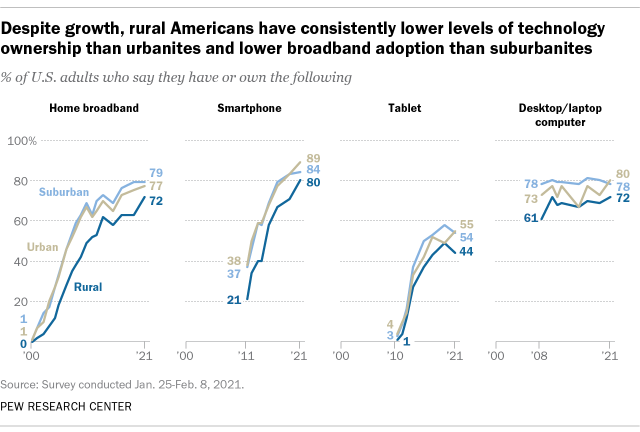Rural Americans have made large gains in adopting digital technology over the past decade and have narrowed some digital gaps. However, rural adults remain less likely than suburban adults to have home broadband and less likely than urban adults to own a smartphone, tablet computer or traditional computer.
Pew Research Center has studied Americans’ internet and technology adoption for decades. Continuing this research, the Center surveyed 1,502 U.S. adults from Jan. 25 to Feb. 8, 2021, by cellphone and landline phone. The survey was conducted by interviewers under the direction of Abt Associates and is weighted to be representative of the U.S. adult population by gender, race, ethnicity, education and other categories. Here are the questions, responses and methodology used for this analysis.
Roughly seven-in-ten rural Americans (72%) say they have a broadband internet connection at home, according to a Pew Research Center survey of U.S. adults conducted from Jan. 25 to Feb. 8, 2021. While broadband adoption has not significantly increased for urban and suburban Americans in the last five years, rural residents have seen a 9 percentage point rise in home broadband adoption since 2016, when about six-in-ten (63%) reported having a high-speed internet connection at home. Despite the rise in rural adoption, rural residents are still less likely than those living in suburban areas to report having home broadband.
As is true for the nation as a whole, mobile technology use among rural adults has also risen rapidly, with the share of those owning smartphones and tablets increasing sharply since 2011. While smartphone ownership rose significantly (9 points) among rural residents in the past three years, their tablet ownership has remained relatively equivalent to what it was in 2019. Similarly, rural ownership of desktop or laptop computers remains largely unchanged.
When looking at differences by community type in technology ownership, rural adults are less likely than urban adults to own traditional or tablet computers. In addition, rural residents are less likely than suburbanites to say they have a tablet.
Rural adults are also less likely than suburban and urban adults to have multiple devices or services that enable them to go online: Three-in-ten adults who live in rural communities report owning or having a desktop or laptop computer, a smartphone, a home broadband connection and a tablet computer, compared with 44% of urban and 43% of suburban adults.
Rural residents go online less frequently than their urban counterparts. Eight-in-ten adults who live in rural communities say they use the internet on at least a daily basis, compared with roughly nine-in-ten of those in urban areas (88%). In addition, three-in-ten or more urban (37%) and suburban (30%) residents say they are online almost constantly while about a quarter of rural residents (23%) say the same.
In a 2018 Center survey, adults who lived in rural areas were more likely to say access to high-speed internet was a major problem in their local community: 24% said this, compared with 13% of urban adults and 9% of suburban adults. Similar rates of concern about access to high-speed internet were shared by rural adults in both lower- and higher-income households, as well as by those with various levels of educational attainment.
These comparably lower levels of adoption among rural residents may be due to a unique feature of rural life. Even though rural areas are more wired today than in the past, current infrastructure does not support consistently dependable broadband access in many rural areas. This lack of reliable high-speed internet access has come to the forefront of discussions about navigating remote work and school during the coronavirus pandemic.
Although rural residents are less likely to be broadband users than are suburban residents, only 29% of rural adults say the government has a responsibility to ensure that all Americans have a high-speed internet connection at home during the coronavirus outbreak. In comparison, 50% of urban residents and 35% of suburbanites say the same, according to previously unexplored data from an April 2020 Pew Research Center survey.
CORRECTION (Oct. 19, 2021): A figure from a 2018 survey was mislabeled in the text of a previous version (the analysis cited was correct). In 2018, 9% of suburban adults said high-speed internet access was a major problem in their community.
Note: Here are the questions, responses and methodology used for this analysis. This is an update of a post originally published May 19, 2017, and later updated on May 31, 2019, by Andrew Perrin.
